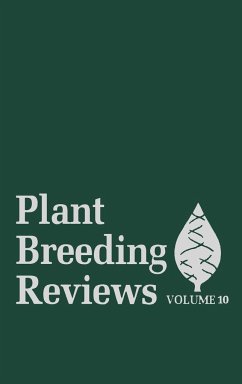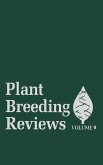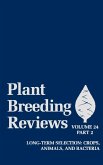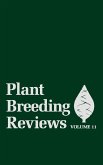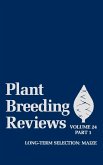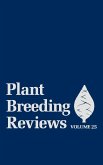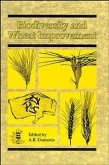Plant Breeding Reviews, Volume 10
Herausgeber: Janick, Jules
Plant Breeding Reviews, Volume 10
Herausgeber: Janick, Jules
- Gebundenes Buch
- Merkliste
- Auf die Merkliste
- Bewerten Bewerten
- Teilen
- Produkt teilen
- Produkterinnerung
- Produkterinnerung
Part of a series which presents papers of topical interest relating to the breeding of plants important to agriculture and horticulture.
Andere Kunden interessierten sich auch für
![Plant Breeding Reviews, Volume 9 Plant Breeding Reviews, Volume 9]() Plant Breeding Reviews, Volume 9380,99 €
Plant Breeding Reviews, Volume 9380,99 €![Plant Breeding Reviews, Volume 24, Part 2 Plant Breeding Reviews, Volume 24, Part 2]() Plant Breeding Reviews, Volume 24, Part 2382,99 €
Plant Breeding Reviews, Volume 24, Part 2382,99 €![Plant Breeding Reviews, Volume 11 Plant Breeding Reviews, Volume 11]() Plant Breeding Reviews, Volume 11382,99 €
Plant Breeding Reviews, Volume 11382,99 €![Plant Breeding Reviews, Volume 24, Part 1 Plant Breeding Reviews, Volume 24, Part 1]() Plant Breeding Reviews, Volume 24, Part 1398,99 €
Plant Breeding Reviews, Volume 24, Part 1398,99 €![Plant Breeding Reviews, Volume 25 Plant Breeding Reviews, Volume 25]() Plant Breeding Reviews, Volume 25398,99 €
Plant Breeding Reviews, Volume 25398,99 €![Biodiversity and Wheat Improvement Biodiversity and Wheat Improvement]() Biodiversity and Wheat Improvement770,99 €
Biodiversity and Wheat Improvement770,99 €![Wastewater Reuse, Volume 1 Wastewater Reuse, Volume 1]() Kader GaidWastewater Reuse, Volume 1164,99 €
Kader GaidWastewater Reuse, Volume 1164,99 €-
-
-
Part of a series which presents papers of topical interest relating to the breeding of plants important to agriculture and horticulture.
Hinweis: Dieser Artikel kann nur an eine deutsche Lieferadresse ausgeliefert werden.
Hinweis: Dieser Artikel kann nur an eine deutsche Lieferadresse ausgeliefert werden.
Produktdetails
- Produktdetails
- Verlag: Wiley
- Volume 10 edition
- Seitenzahl: 392
- Erscheinungstermin: 11. November 1992
- Englisch
- Abmessung: 235mm x 157mm x 27mm
- Gewicht: 781g
- ISBN-13: 9780471573470
- ISBN-10: 0471573477
- Artikelnr.: 22175998
- Herstellerkennzeichnung
- Libri GmbH
- Europaallee 1
- 36244 Bad Hersfeld
- gpsr@libri.de
- Verlag: Wiley
- Volume 10 edition
- Seitenzahl: 392
- Erscheinungstermin: 11. November 1992
- Englisch
- Abmessung: 235mm x 157mm x 27mm
- Gewicht: 781g
- ISBN-13: 9780471573470
- ISBN-10: 0471573477
- Artikelnr.: 22175998
- Herstellerkennzeichnung
- Libri GmbH
- Europaallee 1
- 36244 Bad Hersfeld
- gpsr@libri.de
Jules Janick is the James Troop Distinguished Professor of Horticulture at Purdue University in West Lafayette, IN, USA.
Contributors.
1 Dedication: Ernest Robert Sears (191D-1991) Geneticist par Excellence,
Cytogeneticist Extraordinaire, and a Good Man (George P. Redei).
2 Molecular Biology of Cytoplasmic Male Sterility (Mark E. Williams and
Charles S. Levings, III).
I. Introduction.
II. Plant Mitrochondria.
III. cms-T of Maize.
IV. Chimeric DNA Sequences Associated with CMS.
V. Correlation of the T-urf13 and pcf Genes with Male Sterility.
VI. Restorer Genes.
VII. Mechanisms of CMS.
VIII. Epilogue.
Literature Cited.
3 Plant Metabolism and Heterosis (David Rhodes, Grace C. Iu, Wen-Iu Yang,
and Yiannis Samaras).
I. Introduction.
II. Genetic Models of Heterosis.
III. The Metabolic Balance and Physiological Bottleneck Concepts of
Heterosis.
IV. The Metabolic Basis of Dominance.
V. Genetic and Metabolic Distance.
VI. Concluding Discussion.
Literature Cited.
4 Lethal Equivalents and Genetic Load (Neil O. Anderson, Peter D. Ascher,
and Richard E. Widmer).
I. Introduction.
II. Lethal Equivalents and Genetic Diversity.
III. Comparisons Between Formulae Using Multiple Inbred Generations.
IV. Lethal Equivalents as Predictive Tools for Inbred Line Development.
V. Implications.
Literature Cited.
5 Breeding for Heat Tolerance (Anthony E. Hall).
I. Introduction.
II. Sensitivity to Heat of Different Stages of Plant Development and Plant
Processes.
III. Characterizing Production Environments to Determine the Extent to
Which Heat is Reducing Yield.
IV. Genotype Differences in Heat Tolerance, Inheritance, and Associations
with Other Characters.
V. Selection Techniques and Breeding Methods.
VI. Progress in Breeding for Heat Tolerance and Conclusions.
Literature Cited.
6 Chromosome Manipulations and Genetic Analysis in Medicago (T. J. McCoy
and C. S. Echt).
1. Introduction.
II. Chromosome Manipulations in Medicago.
III. Genetic Analysis of Medicago.
IV. Summary.
Literature Cited.
7 Common Bean Improvement in the Tropics (Shree P. Singh).
I. Introduction.
II. History of Improvement in the Tropics.
III. Breeding Objectives and Strategies.
IV. Breeding Progress.
V. Testing.
VI. Conclusions and Prospects.
Literature Cited.
8 Breeding Cold Hardy Peaches and Nectarines (Richard E. C. Layne).
I. Introduction.
II. Morphological Responses to Low Temperatures.
III. Physiological Responses to Low Temperatures.
IV. Biochemical Responses to Low Temperatures.
V. Physical Responses to Low Temperatures.
VI. Germplasm Variability and Heritability.
VII. Selection for Cold Hardiness.
VIII. Screening Systems for Cold Hardiness.
IX. Summary and Conclusions.
Literature Cited.
9 Genetic Resistance in the Cucurbitaceae to Insects and Spider Mites (R. W
Robinson).
I. Introduction.
II. Sources of Resistance.
III. Testing Techniques.
IV. Resistance Mechanisms.
V. Inheritance of Resistance.
VI. Breeding for Insect Resistance.
Literature Cited.
Subject Index.
Cumulative Subject Index.
Cumulative Contributor Index.
1 Dedication: Ernest Robert Sears (191D-1991) Geneticist par Excellence,
Cytogeneticist Extraordinaire, and a Good Man (George P. Redei).
2 Molecular Biology of Cytoplasmic Male Sterility (Mark E. Williams and
Charles S. Levings, III).
I. Introduction.
II. Plant Mitrochondria.
III. cms-T of Maize.
IV. Chimeric DNA Sequences Associated with CMS.
V. Correlation of the T-urf13 and pcf Genes with Male Sterility.
VI. Restorer Genes.
VII. Mechanisms of CMS.
VIII. Epilogue.
Literature Cited.
3 Plant Metabolism and Heterosis (David Rhodes, Grace C. Iu, Wen-Iu Yang,
and Yiannis Samaras).
I. Introduction.
II. Genetic Models of Heterosis.
III. The Metabolic Balance and Physiological Bottleneck Concepts of
Heterosis.
IV. The Metabolic Basis of Dominance.
V. Genetic and Metabolic Distance.
VI. Concluding Discussion.
Literature Cited.
4 Lethal Equivalents and Genetic Load (Neil O. Anderson, Peter D. Ascher,
and Richard E. Widmer).
I. Introduction.
II. Lethal Equivalents and Genetic Diversity.
III. Comparisons Between Formulae Using Multiple Inbred Generations.
IV. Lethal Equivalents as Predictive Tools for Inbred Line Development.
V. Implications.
Literature Cited.
5 Breeding for Heat Tolerance (Anthony E. Hall).
I. Introduction.
II. Sensitivity to Heat of Different Stages of Plant Development and Plant
Processes.
III. Characterizing Production Environments to Determine the Extent to
Which Heat is Reducing Yield.
IV. Genotype Differences in Heat Tolerance, Inheritance, and Associations
with Other Characters.
V. Selection Techniques and Breeding Methods.
VI. Progress in Breeding for Heat Tolerance and Conclusions.
Literature Cited.
6 Chromosome Manipulations and Genetic Analysis in Medicago (T. J. McCoy
and C. S. Echt).
1. Introduction.
II. Chromosome Manipulations in Medicago.
III. Genetic Analysis of Medicago.
IV. Summary.
Literature Cited.
7 Common Bean Improvement in the Tropics (Shree P. Singh).
I. Introduction.
II. History of Improvement in the Tropics.
III. Breeding Objectives and Strategies.
IV. Breeding Progress.
V. Testing.
VI. Conclusions and Prospects.
Literature Cited.
8 Breeding Cold Hardy Peaches and Nectarines (Richard E. C. Layne).
I. Introduction.
II. Morphological Responses to Low Temperatures.
III. Physiological Responses to Low Temperatures.
IV. Biochemical Responses to Low Temperatures.
V. Physical Responses to Low Temperatures.
VI. Germplasm Variability and Heritability.
VII. Selection for Cold Hardiness.
VIII. Screening Systems for Cold Hardiness.
IX. Summary and Conclusions.
Literature Cited.
9 Genetic Resistance in the Cucurbitaceae to Insects and Spider Mites (R. W
Robinson).
I. Introduction.
II. Sources of Resistance.
III. Testing Techniques.
IV. Resistance Mechanisms.
V. Inheritance of Resistance.
VI. Breeding for Insect Resistance.
Literature Cited.
Subject Index.
Cumulative Subject Index.
Cumulative Contributor Index.
Contributors.
1 Dedication: Ernest Robert Sears (191D-1991) Geneticist par Excellence,
Cytogeneticist Extraordinaire, and a Good Man (George P. Redei).
2 Molecular Biology of Cytoplasmic Male Sterility (Mark E. Williams and
Charles S. Levings, III).
I. Introduction.
II. Plant Mitrochondria.
III. cms-T of Maize.
IV. Chimeric DNA Sequences Associated with CMS.
V. Correlation of the T-urf13 and pcf Genes with Male Sterility.
VI. Restorer Genes.
VII. Mechanisms of CMS.
VIII. Epilogue.
Literature Cited.
3 Plant Metabolism and Heterosis (David Rhodes, Grace C. Iu, Wen-Iu Yang,
and Yiannis Samaras).
I. Introduction.
II. Genetic Models of Heterosis.
III. The Metabolic Balance and Physiological Bottleneck Concepts of
Heterosis.
IV. The Metabolic Basis of Dominance.
V. Genetic and Metabolic Distance.
VI. Concluding Discussion.
Literature Cited.
4 Lethal Equivalents and Genetic Load (Neil O. Anderson, Peter D. Ascher,
and Richard E. Widmer).
I. Introduction.
II. Lethal Equivalents and Genetic Diversity.
III. Comparisons Between Formulae Using Multiple Inbred Generations.
IV. Lethal Equivalents as Predictive Tools for Inbred Line Development.
V. Implications.
Literature Cited.
5 Breeding for Heat Tolerance (Anthony E. Hall).
I. Introduction.
II. Sensitivity to Heat of Different Stages of Plant Development and Plant
Processes.
III. Characterizing Production Environments to Determine the Extent to
Which Heat is Reducing Yield.
IV. Genotype Differences in Heat Tolerance, Inheritance, and Associations
with Other Characters.
V. Selection Techniques and Breeding Methods.
VI. Progress in Breeding for Heat Tolerance and Conclusions.
Literature Cited.
6 Chromosome Manipulations and Genetic Analysis in Medicago (T. J. McCoy
and C. S. Echt).
1. Introduction.
II. Chromosome Manipulations in Medicago.
III. Genetic Analysis of Medicago.
IV. Summary.
Literature Cited.
7 Common Bean Improvement in the Tropics (Shree P. Singh).
I. Introduction.
II. History of Improvement in the Tropics.
III. Breeding Objectives and Strategies.
IV. Breeding Progress.
V. Testing.
VI. Conclusions and Prospects.
Literature Cited.
8 Breeding Cold Hardy Peaches and Nectarines (Richard E. C. Layne).
I. Introduction.
II. Morphological Responses to Low Temperatures.
III. Physiological Responses to Low Temperatures.
IV. Biochemical Responses to Low Temperatures.
V. Physical Responses to Low Temperatures.
VI. Germplasm Variability and Heritability.
VII. Selection for Cold Hardiness.
VIII. Screening Systems for Cold Hardiness.
IX. Summary and Conclusions.
Literature Cited.
9 Genetic Resistance in the Cucurbitaceae to Insects and Spider Mites (R. W
Robinson).
I. Introduction.
II. Sources of Resistance.
III. Testing Techniques.
IV. Resistance Mechanisms.
V. Inheritance of Resistance.
VI. Breeding for Insect Resistance.
Literature Cited.
Subject Index.
Cumulative Subject Index.
Cumulative Contributor Index.
1 Dedication: Ernest Robert Sears (191D-1991) Geneticist par Excellence,
Cytogeneticist Extraordinaire, and a Good Man (George P. Redei).
2 Molecular Biology of Cytoplasmic Male Sterility (Mark E. Williams and
Charles S. Levings, III).
I. Introduction.
II. Plant Mitrochondria.
III. cms-T of Maize.
IV. Chimeric DNA Sequences Associated with CMS.
V. Correlation of the T-urf13 and pcf Genes with Male Sterility.
VI. Restorer Genes.
VII. Mechanisms of CMS.
VIII. Epilogue.
Literature Cited.
3 Plant Metabolism and Heterosis (David Rhodes, Grace C. Iu, Wen-Iu Yang,
and Yiannis Samaras).
I. Introduction.
II. Genetic Models of Heterosis.
III. The Metabolic Balance and Physiological Bottleneck Concepts of
Heterosis.
IV. The Metabolic Basis of Dominance.
V. Genetic and Metabolic Distance.
VI. Concluding Discussion.
Literature Cited.
4 Lethal Equivalents and Genetic Load (Neil O. Anderson, Peter D. Ascher,
and Richard E. Widmer).
I. Introduction.
II. Lethal Equivalents and Genetic Diversity.
III. Comparisons Between Formulae Using Multiple Inbred Generations.
IV. Lethal Equivalents as Predictive Tools for Inbred Line Development.
V. Implications.
Literature Cited.
5 Breeding for Heat Tolerance (Anthony E. Hall).
I. Introduction.
II. Sensitivity to Heat of Different Stages of Plant Development and Plant
Processes.
III. Characterizing Production Environments to Determine the Extent to
Which Heat is Reducing Yield.
IV. Genotype Differences in Heat Tolerance, Inheritance, and Associations
with Other Characters.
V. Selection Techniques and Breeding Methods.
VI. Progress in Breeding for Heat Tolerance and Conclusions.
Literature Cited.
6 Chromosome Manipulations and Genetic Analysis in Medicago (T. J. McCoy
and C. S. Echt).
1. Introduction.
II. Chromosome Manipulations in Medicago.
III. Genetic Analysis of Medicago.
IV. Summary.
Literature Cited.
7 Common Bean Improvement in the Tropics (Shree P. Singh).
I. Introduction.
II. History of Improvement in the Tropics.
III. Breeding Objectives and Strategies.
IV. Breeding Progress.
V. Testing.
VI. Conclusions and Prospects.
Literature Cited.
8 Breeding Cold Hardy Peaches and Nectarines (Richard E. C. Layne).
I. Introduction.
II. Morphological Responses to Low Temperatures.
III. Physiological Responses to Low Temperatures.
IV. Biochemical Responses to Low Temperatures.
V. Physical Responses to Low Temperatures.
VI. Germplasm Variability and Heritability.
VII. Selection for Cold Hardiness.
VIII. Screening Systems for Cold Hardiness.
IX. Summary and Conclusions.
Literature Cited.
9 Genetic Resistance in the Cucurbitaceae to Insects and Spider Mites (R. W
Robinson).
I. Introduction.
II. Sources of Resistance.
III. Testing Techniques.
IV. Resistance Mechanisms.
V. Inheritance of Resistance.
VI. Breeding for Insect Resistance.
Literature Cited.
Subject Index.
Cumulative Subject Index.
Cumulative Contributor Index.

